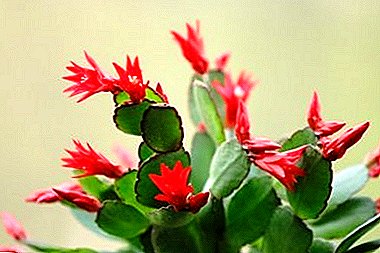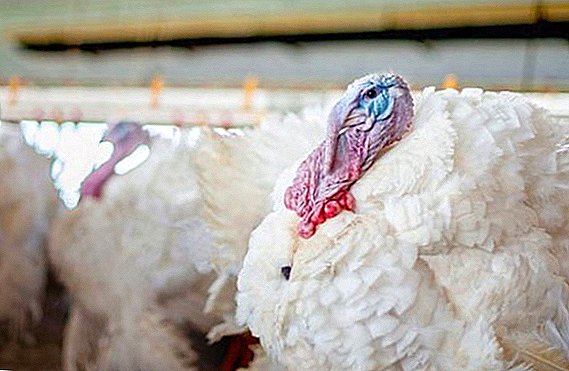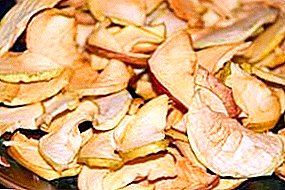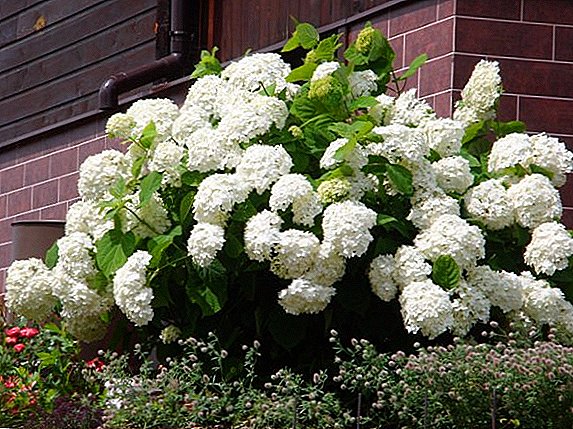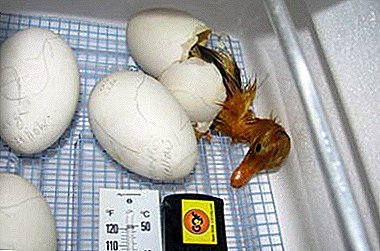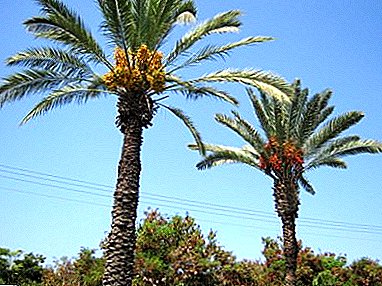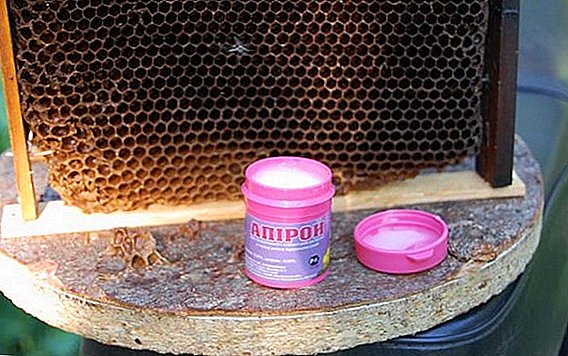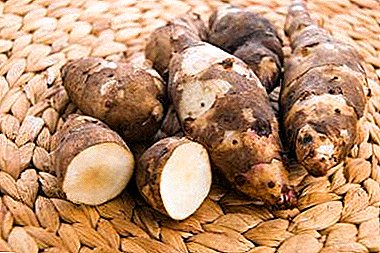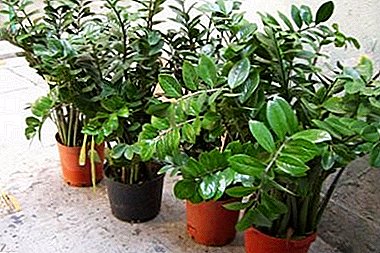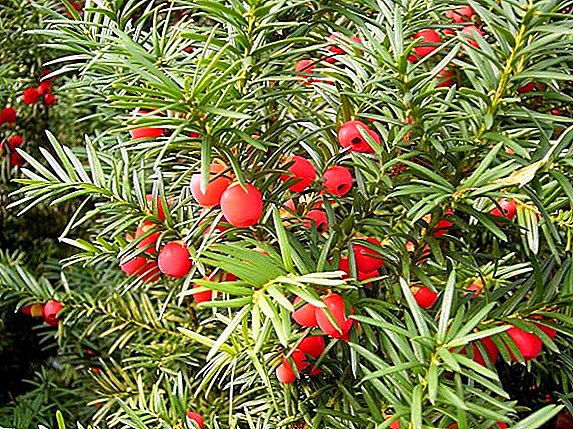 Many of the trees that we plant in the garden or on the backyard plot do not differ in life expectancy, but today we will discuss a tree that has been growing for thousands of years - the yew berry. Consider what a yew tree is, provide a photo and an accurate description of the plant, and also tell about planting and growing a long-liver.
Many of the trees that we plant in the garden or on the backyard plot do not differ in life expectancy, but today we will discuss a tree that has been growing for thousands of years - the yew berry. Consider what a yew tree is, provide a photo and an accurate description of the plant, and also tell about planting and growing a long-liver.
Botanical description
Let's start with the answer to the most interesting question about how much the berry yew lives. Since no one person can live so much, the data is rather vague. On average, the tree lives from 1500 to 3-4 thousand years. Imagine such a life expectancy is incredibly difficult, but it is worth noting that the vagaries of weather, climate change and various parasites significantly shorten the life of a yew.
Yew berry is also called mahogany or greenery, which is worth knowing when buying or looking for a seedling. Zelenitsa grows up to 27 m, having a trunk diameter of about 150 cm. Given that mahogany grows slowly, the average height will be within 10-20 m. 
The crown has a cylindrical shape with smooth edges. Very thick, possibly forming several tiers. The bark is smooth, painted in a reddish-gray color.
It is worth paying attention to the fact that the trunk is covered with sleeping buds. They give rise to new shoots.
The needles are dense, on the outside dark green, on the inside - light green.
Cones are solitary, covered with red skin, which grows into a rather large cushion with a sweet taste. 
Seeds are quite hard, oval-shaped. Pollination takes place in late April - early May.
Important! The whole plant is poisonous, except for the skin that covers the seed buds.
Select a site
Having dealt with what is a yew berry, after seeing the photo and description of the plant, it is worth going to the selection of a site for our long-lived conifer tree.
Lighting and location
Mahogany is shade-tolerant plant. Young trees should be planted under the crown of large trees so that they receive diffused sunlight.
In addition to berry yew, shade-tolerant plants are also: spruce, shadberry, cedar, cypress, maple, fir, mountain ash, privet, elderberry and weigela.

As for the choice of location, it must be special in all plans. The yew does not like polluted soil, so the landing should be carried out precisely in a clean substrate, which is devoid of heavy metals, various construction or domestic waste. Also, the lowlands do not fit the tree, as it does not tolerate over-wetting of the soil, therefore we choose a flat place or a small hill, which will be closed from direct sunlight.
Did you know? The oldest is considered the Fortingel yew, under the crown of which, according to legend, the childhood of Pontius Pilate passed.
What kind of soil does yew like
The ideal option would be fertile well-drained soil with a neutral or slightly acid reaction. You may be misled by the fact that various sources describe the ideal substrate in their own way. 
The fact is that different species and varieties of yew require radically different soil, with which their habitat is associated. For example, yew average loves weak alkaline soil and yew spiky - neutral.
It is also worth considering that if soils predominate on your site that trap moisture, then you will have to worry about good drainage.
Planting seedlings
To begin with, if you plant several trees in a row or in the form of a figure, then between them you need to leave about 2 meters of space, otherwise you will get "woven" thick crowns, which will be very difficult to correctly form, especially since a similar fit will shade the plot very much.
We start with the preparation of a pit or ditch (landing for a hedge). The depth should be about 70 cm. diameter - 1 m. 
Next, prepare the soil mix. We need to take sand, peat, sod land and mix them in a ratio of 2: 2: 3. You can replace the turf ground sheet, from this radically nothing changes.
Important! When planting do not need to add any fertilizer, including humus or compost.After immersion of the rhizome in the pit, gently correct it to increase the suction area. It is advisable to "sit down" the center of the root system on a small hill formed from the prepared soil. Then gradually fall asleep pit, slightly tamping it. We do not need air pockets that will not allow the roots to come into contact with the soil.

In the end, we irrigate so that the soil is moist but not too humid. 
Do not forget that the root neck should be at ground level. Do not sprinkle it with earth or mulch.
We recommend to grind the tree trunk with sawdust to solve the problem with weeds and drying out of the ground. Mulch need 10 cm layer.
Breeding methods
Next, we consider two variants of reproduction long-liver. You can choose the option that is more convenient for you in terms of costs or preferences. From this does not depend on the speed of growth or development of the tree.
Long and ineffective (seeded)
Immediately answer the question of why this method is ineffective. The fact is that seeds require stratification - The effects of low temperatures that mimic the natural conditions required for germination. In addition, seed can rise not in a year, but in 2-3 or 4 years, since germination persists for four years. 
It turns out that when sowing seeds, you will not know how long the seedlings will sprout, especially since they germinate unevenly.
Also, this method of reproduction is used very rarely for the reason that the berry yew is not bisexual, therefore pollination requires two trees of different sexes, which must be 25 years old or more.
If you are determined to grow a yew from seed, then proceed to the preparation of seed. Collection of seed buds is carried out in September - October, when the skin on them turns red. It is worth being attentive, as many birds love to eat the sweetish pulp along with the seeds, so collect the material in time, otherwise you will have to wait for the next year. After harvesting, you need to soak the fruits so that it is easier to remove the softened "packaging", but do not hold the cones in water for a long time, otherwise they will ferment. 
After cleaning, the seeds are dried and placed in a refrigerator on a stratification, which is carried out until next autumn. You can wait and sow in the spring (1.5 years of stratification), and then the seedlings will appear in 2 months.
If you have chosen autumn sowing, then prepare a greenhouse or greenhouse for sowing. On 1 square. m consumes about 500 seeds who sow randomly. No need to dig holes or make deep grooves, just pour the seeds on the ground and cover them with mulch from a dry coniferous litter (another mulch will not work).
It is worth remembering that stratification does not imply the aging of seeds only in a cold place. Initially, the temperature should be from 1 to 5 ° C, then the seeds move to a warm place (about +20 ° C), then again in the cold and, when the seeds start to bite, to a moderately warm one. 
Important! After germination, seedlings are grown in the greenhouse for 2 years, after which they are moved to the garden bed.
Fast and productive (grafting)
To begin with, depending on the location of the shoot taken for the cutting, the structure of the seedling will vary in the future, therefore, when buying a seedling, you cannot know what will happen in the end. For example, if a horizontal lower shoot was taken, then you will get a spreading tree that will resemble a large shrub, but if you take an escape that was directed upwards, then a slender tall tree will grow from it.
Cuttings are carried out in September-October, immediately after full ripening. So you get a good ripe material. The length of the cutting should be within 15-20 cm, there should also be several processes on the shoot. 
For cutting it is better to use 3-5-year-old branches, as they take root faster and go to growth. Annuals can also be used, but they take root more slowly.
Important! Older mother plants produce material that takes root very badly without a growth stimulator.After cutting the needles are removed from the bottom, all the cuttings are placed for several hours in a root growth stimulator, and then they are planted in a mixture of peat and sand (2: 1). Planting is carried out in small boxes, which in the cold season are moved to a greenhouse or greenhouse.
Rooting the stalk will be about a decade, then in February or March, the plants are planted in single pots. Next yew can be planted in open ground, waiting for warm weather.
It should be noted that when grown in open ground, the tree takes 6-7 years, but if the first two years the young trees spend in the greenhouse, then this period will be reduced to 5 years.
Also yew can be propagated by layering. For new plants, you need to bend the lower branches so that they touch the ground. In a few years, rooting of the layers will take place, after which they can be separated from the parent plant and grown as full-fledged seedlings.
How to care for a plant
It's time to discuss the care of the plant, to consider the main points that affect the life expectancy of the tree and its condition. It should be noted that comfortable conditions are required for a tree not only at the initial stage, but also throughout life, since deterioration leads to diseases. 
Watering and soil care
Young trees have a small rhizome, so they can not independently provide themselves with moisture. A prolonged drought can lead to death, so the soil is moistened as it dries, avoiding stagnant water.
Mature trees that have turned 20-30 years old or more can do without watering, as their roots go deeper, reaching the level of groundwater, and a large area of rhizomes is able to absorb maximum moisture during rain.
However, it is worth remembering that if your region has a very hot dry summer, then watering still need to be carried out. The same applies to areas on which a layer of clay or minerals is high, which prevent the tree from rooting deep.
Did you know? Yew alkaloids are used in traditional medicine for the manufacture of anticancer drugs.

Pruning
The dense crown of the yew makes it possible to form almost any shape, up to the creation of the shape of animals in natural sizes.
Also yew is the best tree to form, as its slow growth keeps the conceived picture for several years, after which small adjustments are required.
If you do not want to create a certain form, then annually remove dry shoots so that the tree retains a spectacular look.
Any pruning is best done in the spring so that the tree spends less effort building up the green mass. 
Transfer
Tree transplantation is carried out in April - May, depending on weather conditions. It should be warm and dry outside.
Prepare a pit with a depth of 50-60 cm and a diameter slightly larger than the diameter of the earth coma on the roots. Next, prepare a soil mixture, identical to that used in planting the seedling. At the bottom of the hole lay a 15 cm layer of fine crushed stone or expanded clay, to get a good drainage.
Then we pour our mixture on top of the drainage, place the rhizomes in the center so that the basal neck is at the level of the ground (you can add a few centimeters, which will go away when mulch is laid). We fall asleep a hole, slightly tamping the soil. In the process of filling the hole, you need to pour in water several times so that the soil is equally wetted. Mulch pristvolny circle large wood chips. We draw attention to the fact that if a new place is in direct sunlight, then you need to put some shed until the tree takes root. Lack of shelter will result in burns.
Familiarize yourself with all the subtleties of growing yew, planting and care at the dacha.

Wintering
Young trees are afraid of frost, so they need to be properly covered. The lower part of the trunk is covered with spruce leaves, and the branches, which become brittle in the cold, are tied into a bundle and tied to a support so that the wind does not break them. It is worth considering that in the case of using a non-woven cover for the shoots, leave an air gap between the wood and the material.
Important! In early spring, yew can suffer from sunburn, so you need to cover it with kraft paper or put a canopy.

Diseases and pests
Let's start with sucking pests that affect all the trees in the garden, including berry yew. If you see dry, dull or yellow needles, and the tree itself has an oppressed look, then you should check the plant for pests. Yews can infect ticks, scale insects, aphids or bedbugs. To fight insects you need in early spring before bud break. The whole tree is treated with insecticides of a wide spectrum of action in order to protect it from the most "popular" parasites.
- Gnawing pests

- Pine scoop
We turn to diseases that are most often caused by improper planting or lack of tree care. 
- Brown shutte
- Fusarium
Did you know? The yew was exterminated because of its "eternal" wood, which has bactericidal properties. Wood is able to clean the air of disease-causing organisms, so it was massively used to build houses.
Use in landscape design

Yew tree is a valuable tree not only because it is listed in the Red Book, but also because of "capriciousness". This tree can not be grown in urban areas or near factories, so the presence of large plantings yew suggests that the air and land in the area are not polluted.
Yew berry in landscape design is used as a background for rock gardens, creating dense hedges or green sculptures. Trees are used to create labyrinths or compositions.
Also yew can be used for single landings on the plot or as a separation planting in the garden.
It is worth remembering that all parts of the plant are poisonous, so children or animals should not be allowed near the tree. Poisoning can be fatal.
This is basic information about what a yew berry tree is, what it is used for, what are the rules of care and planting. In conclusion, it should be said that, by planting this plant, you do not let another beautiful species of tree, which has been destroyed for centuries, disappear.


